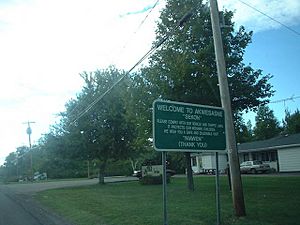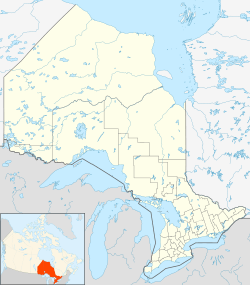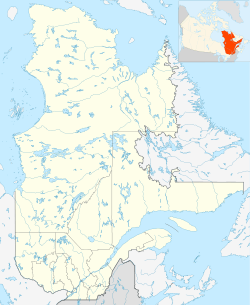Akwesasne facts for kids
Quick facts for kids
Akwesasne
Ahkwesáhsne (Mohawk)
|
||
|---|---|---|
|
Mohawk Territory
|
||
| Mohawk Nation at Akwesasne | ||

Road sign in Akwesasne
|
||
|
||

Map of the Mohawk Nation at Akwesasne
|
||
| Permanently Settled | 1754 | |
| Area | ||
| • Land | 85.89 km2 (33.16 sq mi) | |
| Population | ||
| • Total | 14,000 | |
| Demonym(s) | Akwesasro꞉non | |
| Time zone | UTC−5 (Eastern (EST)) | |
| • Summer (DST) | UTC−4 (EDT) | |
| Postal code span/ZIP Code |
H0M 1A0 & H0M 0A1, 13655, K6H 5R7
|
|
| Area codes | 518, 613, 343 | |
| Website | https://www.srmt-nsn.gov | |
The Mohawk Nation at Akwesasne (pronounced AK-wə-SAS-neh) is a special territory of the Mohawk Nation (who call themselves Kanienʼkehá:ka). It is located right where the borders of the United States and Canada meet. It also crosses the borders of the Canadian provinces of Ontario and Quebec.
Even though it's divided by an international border, the people living there see themselves as one community. They have their own police forces because of different laws in each country.
The community started in the mid-1700s. Mohawk families from Kahnawake, a Catholic Mohawk village near Montreal, moved there. Today, Akwesasne has about 12,000 residents. It is the largest Kanienʼkehá:ka community in terms of people and land.
Akwesasne was one of the Seven Nations of Canada. The Kanienʼkehá:ka (Mohawk) people are known as "people of the flint" in their language. Other Mohawk territories in Canada include Kahnawake, Wahta, Tyendinaga, Kanesatake, and Six Nations of the Grand River.
After the American Revolutionary War, the border between Canada and the United States was set. A larger part of Akwesasne ended up in the United States. This part is known as the St. Regis Mohawk Reservation. The part in Ontario is called Akwesasne Reserve No. 59. The parts in Quebec are called Akwesasne 15.
The name Akwesasne in the Mohawk language means "Land Where the Partridge Drums." This name shows how much wildlife was in the area.
Contents
Where is Akwesasne?
Akwesasne territory includes parts of the St. Lawrence River. It also has the mouths of the Raquette and St. Regis rivers. Many islands in these three rivers are part of Akwesasne too.
The territory is split north and south by the Canada–United States border. The northern part is further divided by the Canadian provincial border. Ontario is to the west, and Quebec is to the east.
Connecting the Communities
The Three Nations Crossing is a bridge system. It connects Kawehno:ke (Cornwall Island, Ontario) to the city of Cornwall in the north. It also connects to Rooseveltown, New York, in the south.
Because of the St. Lawrence River and the US border, the Quebec part of Akwesasne is like an exclave. This means it's a part of Canada that is separated from the main part by another country's territory. To travel by land from Tsi Snaihne or Kana:takon (in Quebec) to other parts of Canada, you must drive through New York State.
In New York, the Akwesasne territory is the same as the St. Regis Mohawk Reservation. This part is crossed by New York State Route 37. This highway runs for about 127 miles.
A Look Back: Akwesasne's History
Around 1000 AD, Native American groups near the Great Lakes started growing maize (corn). By the 1300s, Iroquoian-speaking people built strong villages along the St. Lawrence River. These included Stadacona and Hochelaga. French explorer Jacques Cartier visited them in the 1500s.
These people spoke a language called Laurentian. But by the early 1600s, when Samuel de Champlain explored the area, the villages were gone. Historians think the stronger Mohawk from the south fought them. The Mohawk wanted control of the fur trade and hunting grounds along the river. By 1600, the Mohawk used the valley for hunting and as a path for war parties.
Founding Akwesasne
In the early 1600s, some Christian Iroquois moved from New York to Kahnawake. This was a Catholic mission village started by French Catholic priests near Montreal. Many different Native American groups joined this community and became Catholic. The Mohawk were the largest group.
During the colonial years, this community was involved in the fur trade. Some men traveled to Albany, New York, to get better prices from the English and Dutch traders.
In the mid-1750s, about 30 families left Kahnawake. They moved upriver to start a new community because their land was getting used up. Leaders included chiefs John and Zachariah Tarbell. A French priest, Father Pierre-Robert-Jean-Baptiste Billiard, went with them. The French government supported this move. They wanted to keep the Mohawk as allies before the Seven Years' War (also called the French and Indian War).
The Tarbell brothers were born to English colonists in Massachusetts. They were captured as children in 1707 during Queen Anne's War. They were taken to Montreal and became Catholic. They were adopted by Mohawk families in Kahnawake and learned the Mohawk language and ways. They married daughters of chiefs and raised their children as Mohawk. Both became chiefs, showing how the Mohawk welcomed new people into their tribe.
In 1755, French-Canadian Catholic priests started the St. Regis Mission at Akwesasne. The Tarbell brothers were among the founding chiefs. The priests first built a simple church, then a log church. In 1795, the Mohawk finished building a stone church, which is still there today. The mission was named after a French priest, St. Jean-François Regis. This name was also used for the nearby river, an island, and later for the St. Regis Mohawk Reservation in New York. The villagers now call their community Kana꞉takon, which means "the village" in Mohawk.
The American Revolution and Borders
After the Seven Years' War, the British took control of Canada. They allowed the Kanienʼkehá:ka to keep their Catholic priests. The priests helped save Mohawk culture by translating the Bible into Mohawk. They also kept church records that showed the Mohawk names of individuals.
During the American Revolutionary War, the Mohawk and other Iroquois nations sided with the British. After the American colonists won, many Iroquois moved to Canada. Some Mohawk joined the growing community at Akwesasne. The Jay Treaty allowed the Iroquois to cross the new border between Canada and the United States. This helped them keep their trade and tribal connections.
Dundee Land Claim
In the early 1800s, non-Native settlers rented a part of the Akwesasne reserve in Quebec called Dundee. In 1888, the government asked the Mohawk to give up this land. The Mohawk agreed, but they always said it wasn't their true intention to give up the land. In 2018, the Akwesasne First Nation accepted a payment of $240 million for the Dundee land. This was 37 years after they first asked the Canadian government for it.
Modern Akwesasne
Kana:takon School, once called Saint Regis Village School, was run by Catholic Sisters until the 1970s. Today, the mission is still active with a church and cemetery. Church records show that priests respected Mohawk traditions.
Akwesasne has Catholic churches that are part of three different church areas. This is because of the international and provincial borders.
In the 1930s, the US government wanted tribes to adopt elected governments. The Mohawk chose to keep their traditional system of hereditary chiefs.
In the 1940s, Ernest Benedict started Akwesasne's first newspaper, Kawehras! ("It Thunders!"). He wrote about the Mohawk's resistance to the US government's election system. In 1948, a vote showed strong support for the traditional "Six Nations Chiefs." Even though the elected chiefs resigned, the government still required elections.
In 1969, Ernest Benedict also started the North American Indian Travelling College. This is now called the Native North American Travelling College. It is a cultural center, publisher, and resource for classes. It has an art gallery and theater.
Around the same time, Benedict started Akwesasne Notes. This newspaper became very important and was the largest Native American newspaper in the world. It often included posters with photos by Edward Curtis and quotes from Native American authors.
In 1987, the Akwesasne Task Force on the Environment was created. This group works to address environmental concerns, like pollution from industries along the St. Lawrence River.
In the 1990s, the people of Akwesasne raised money to fix up their St. Regis Church. They also wrote a history of the church.
Life in Akwesasne Today
Akwesasne is made up of three main areas:
- Kawehno:ke (Cornwall Island, Ontario)
- Kana:takon (Saint Regis, Quebec)
- Tsi Snaihne (Snye, Quebec or Chenail, Quebec)
Other smaller areas include Raquette Point, Hogansburg, Frogtown, and several islands.
Akwesasne borders the towns of Brasher, Fort Covington, and Bombay in New York. To the west is Massena, New York. Most Akwesasne residents speak English in their daily lives.
On the Canadian side, Akwesasne borders the towns of Cornwall in Ontario and Dundee in Quebec.
How Akwesasne is Governed
In 2016, Akwesasne created its own independent legal system and court. This system handles non-criminal issues within the reserve. It has 32 new laws that cover civil matters. The legal team includes a director of public prosecution, a public prosecutor, and two justices.
This system focuses on restorative justice. This means it tries to find solutions that help both the person accused and the person who was harmed. Members of the legal team do not need a law degree. They must complete special training and be approved by a review commission.
Learning and Media
Akwesasne has five elementary schools. Three are run by the Ahkwesasne Mohawk Board of Education:
- Ahkwesahsne Mohawk School (Kindergarten to grade 8)
- Kana:takon School (Kindergarten to grade 5)
- Tsi Snaihne School (Kindergarten to grade 8)
One school is part of the Salmon River Central School District of New York:
- St. Regis Mohawk School (Pre-Kindergarten to grade 6)
One school is run independently:
- Akwesasne Freedom School (Pre-Kindergarten to grade 8). This school teaches mostly in the Kanienʼkehá (Mohawk) language. This helps strengthen the language and culture. Many adults are now taking language classes too. Other communities are learning from Akwesasne's success in bringing back their language and culture.
Most students travel off the reservation for high school. For college, Iohahi:io Akwesasne Education & Training Institute offers programs on the reservation. The State University of New York (SUNY) also has extension programs there.
Radio and News
- 97.3 CKON-FM is the community radio station. It started in 1984. It plays country music and also has adult contemporary music, free format shows, and oldies. CKON also broadcasts hockey and lacrosse games.
- WICY is a radio station from Malone, New York. It has an FM transmitter in Akwesasne at 103.5 W278CS.
- 87.9 FM Karennaon:we started in 2017. It plays music and language from the Haudenosaunee confederacy and other First Nations. It helps children learn the language and culture 24 hours a day.
Other media include:
- Akwesasne Notes (newspaper)
- Indian Time Newspaper
- Akwesasne TV
Fun Things to Do in Akwesasne
- Akwesasne Annual International Pow-wow (a gathering for Native American dancing, singing, and culture)
- Akwesasne Cultural Center
- Akwesasne Mohawk Casino
- Annual Akwesasne Winter Carnival
- Iohahi:io Akwesasne Education & Training Institute
- Mohawk International Raceway (a place for dirt track racing and concerts)
- Ronathahon:ni Cultural Centre (formerly the Native North American Traveling College)
- Strawberry Music Festival
Notable Akwesasne People
- Mary Kawennatakie Adams (1917–1999), a textile artist and basket maker.
- Ernest Benedict (1918–2011), an educator, activist, and Mohawk chief.
- Louis Bruce (1877–1968), a baseball player.
- Katsi Cook, a midwife, environmentalist, and advocate for Native American rights and women's health.
- Doug George-Kanentiio, an editor, author, and co-founder of Akwesasne Communications Society.
- John Kahionhes Fadden (1938–2022), an artist and educator.
- Alex Jacobs, an artist, poet, and radio host.
- Margaret Jacobs, an artist.
- Kiawentiio, an actress and singer-songwriter.
- Mary Leaf (1925–2004), a basket maker.
- Mike Kanentakeron Mitchell, a politician.
- Brandon Oakes, an actor, artist, and dancer.
- Levi Oakes (1925–2019), a code talker (someone who used their Native language to send secret messages during war).
- Richard Oakes (1942–1972), an activist.
- Marlana Thompson, a beadwork artist and fashion designer.
- Shirley Hill Witt, an anthropologist, educator, author, and civil rights activist.
See Also
 In Spanish: Akwesasne para niños
In Spanish: Akwesasne para niños







